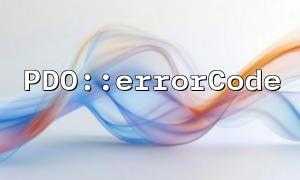In PHP, when performing database operations using PDO (PHP Data Objects), a proper error handling mechanism is an essential part of ensuring program stability and debugging efficiency. PDO offers multiple error handling modes to help developers address errors in database operations more flexibly. This article focuses on how to combine the PDO::errorCode and PDO::setAttribute functions to adjust the error handling mode of PDO for more effective error management.
The default error handling mode in PDO is PDO::ERRMODE_SILENT, meaning that no exceptions are thrown, and no error messages are output when an error occurs. While this mode prevents error messages from being exposed to the user, it can be inconvenient for debugging during development. To address this issue, PDO offers three main error handling modes:
PDO::ERRMODE_SILENT: The default silent mode, which does not throw exceptions or output error messages.
PDO::ERRMODE_WARNING: A PHP warning is issued when an error occurs.
PDO::ERRMODE_EXCEPTION: A PDOException is thrown when an error occurs.
Through the PDO::setAttribute method, developers can flexibly set the appropriate error handling mode.
PDO::setAttribute is a function used to set PDO instance attributes. With this function, we can control the behavior of PDO, one of the most important attributes being PDO::ATTR_ERRMODE, which is used to specify the error handling mode.
<?php
// Create PDO object
$dsn = 'mysql:host=localhost;dbname=testdb';
$username = 'root';
$password = '';
$options = array(
PDO::ATTR_ERRMODE => PDO::ERRMODE_EXCEPTION, // Set error mode to exceptions
PDO::ATTR_DEFAULT_FETCH_MODE => PDO::FETCH_ASSOC, // Set default fetch mode
);
<p>try {<br>
$pdo = new PDO($dsn, $username, $password, $options);<br>
} catch (PDOException $e) {<br>
echo 'Connection failed: ' . $e->getMessage();<br>
}<br>
?><br>
In this example, PDO::ATTR_ERRMODE => PDO::ERRMODE_EXCEPTION causes an exception to be thrown when a database operation fails, allowing the developer to catch the exception and handle it accordingly.
PDO::errorCode is a method used to retrieve the error code of the last database operation. This method returns a database driver-specific error code, which helps developers determine the type of error when it occurs.
<?php
// Assume the PDO object has been created and a database operation has been performed
$query = $pdo->query('SELECT * FROM non_existent_table');
if ($query === false) {
$errorCode = $pdo->errorCode();
echo "Error Code: " . $errorCode; // Output error code
}
?>
In this example, the query attempts to access a non-existent table. If the query fails, $pdo->errorCode() will return the corresponding error code, allowing the developer to handle the error based on the code.
By combining the use of PDO::setAttribute and PDO::errorCode, developers can both catch exceptions when errors occur and retrieve detailed error codes, making error handling more precise.
<?php
// Create PDO object and set error mode to throw exceptions
$pdo = new PDO($dsn, $username, $password);
$pdo->setAttribute(PDO::ATTR_ERRMODE, PDO::ERRMODE_EXCEPTION);
<p>try {<br>
$query = $pdo->query('SELECT * FROM non_existent_table');<br>
} catch (PDOException $e) {<br>
// Output detailed error information when an exception is caught<br>
echo "Caught Exception: " . $e->getMessage();<br>
// Use errorCode to get error code<br>
$errorCode = $pdo->errorCode();<br>
echo " Error Code: " . $errorCode;<br>
}<br>
?><br>
With this approach, developers can catch the PDO exceptions in a try-catch block and use PDO::errorCode to retrieve more detailed error information, helping to quickly pinpoint issues.
By properly using PDO::setAttribute and PDO::errorCode, developers can effectively adjust the error handling mode of PDO and improve the robustness of database operations. In production environments, PDO::ERRMODE_EXCEPTION is typically used to ensure that errors are caught and handled in a timely manner. During development, PDO::ERRMODE_WARNING can be set to facilitate debugging. By combining the errorCode method, developers can precisely obtain specific error codes, further enhancing the program's fault tolerance and error handling capabilities.
With flexible error mode adjustments and error code retrieval, developers can better manage PDO database operation error information, making database operations safer and more reliable.


